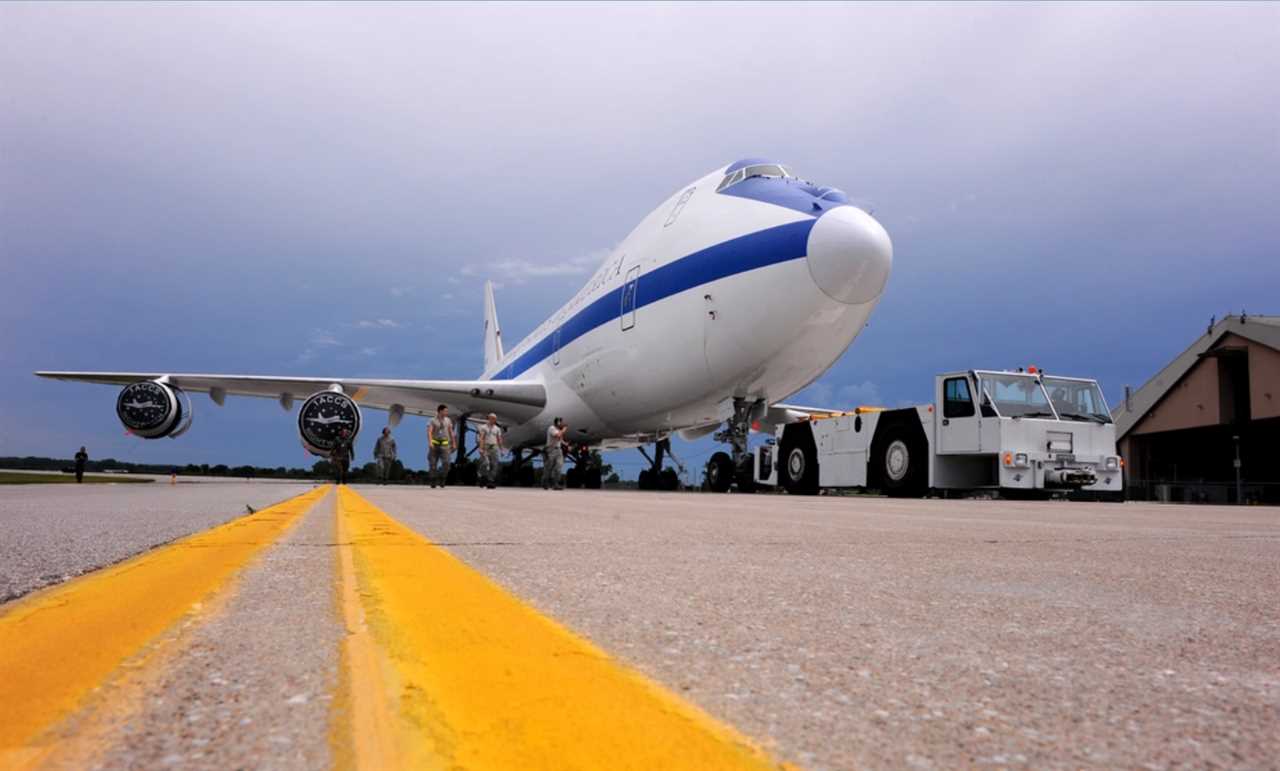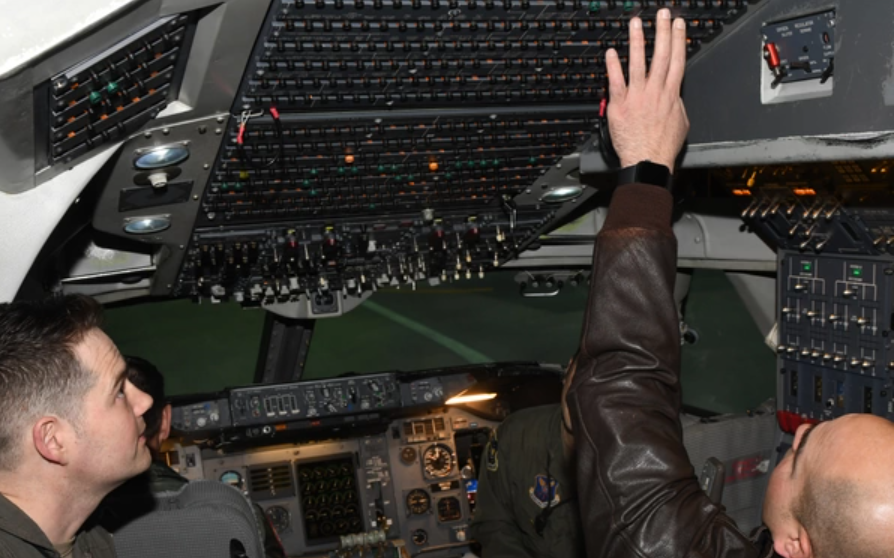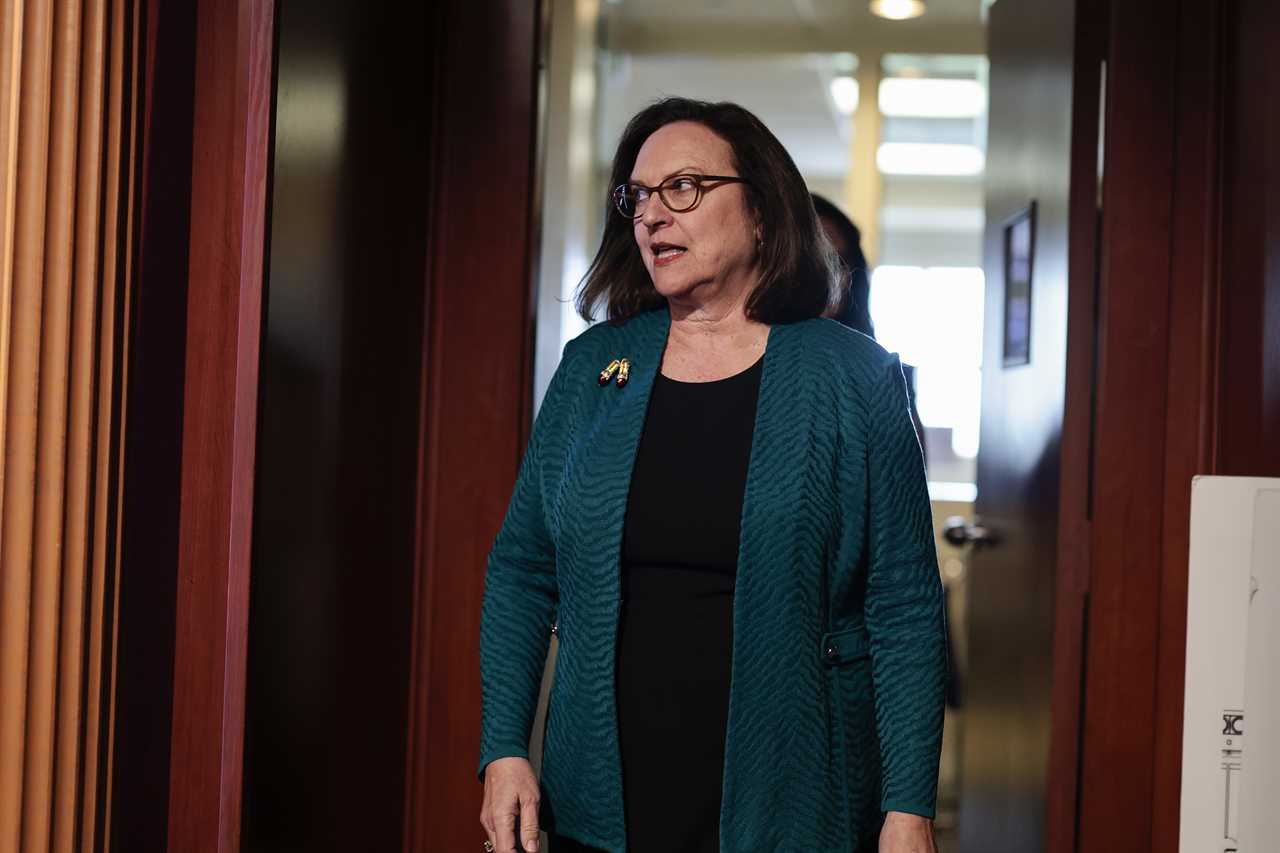
ABOARD AN E-4B DOOMSDAY PLANE — Inside a military aircraft designed to survive a nuclear war, an area once used as a first class lounge now contains six blue passenger seats next to two sleeping bunks.
Maj. Ted DeBonis, maintenance squadron commander, says it’s a break area for the 12 aircraft mechanics who accompany the plane on every hop, waiting to fix it anywhere in the world.
It’s an unusual setup for a military aircraft. But a flying maintenance hangar is the kind of thing you need when you’re operating a plane that’s been around since the Carter administration.
This wide-body jumbo jet, tail number 75-1025, is one of four Boeing 747-200s that are custom-made to keep the government operating in the event of an infrastructure-shattering nuclear war. Commonly referred to as the “Doomsday planes,” these E-4B Nightwatch aircraft typically fly the defense secretary or the chair of the Joint Chiefs of Staff around the world.
And as Russian President Vladimir Putin threatens nuclear war over Western allies’ response to his invasion of Ukraine, these flying fallout shelters are more relevant than they’ve been in a generation.
Yet the planes are showing their age. And the replacement, still at least half a decade away, has for years lost out to internal budget battles that tend to favor shiny new fighter jets and bombers.
Even if the replacement program gets all the money the Air Force is requesting this year, the new planes won’t be delivered until 2027, meaning the existing aircraft will need to fly well past their 50th birthday.
It’s a situation that has experts and defense industry advocacy groups on edge.
“[The Air Force and Congress] need to get very real about this recapitalization,” said Douglas Birkey, executive director at Mitchell Institute for Aerospace Studies, “or they will see some very severe risks adopted that shouldn't be.”
A retro chic bunker
The Boeing 747 used to be known as the “queen of the skies.” But major commercial airlines that flew the 200 series retired them in the late 1990s and early 2000s, which means the Air Force has flown these planes for 20 years past their expected lifespan, Birkey said.
To celebrate the mission’s 60th anniversary and give an inside peek at what it’s like to work at the National Airborne Operations Center, the Air Force invited a group of reporters for a two-hour flight over Nebraska, Iowa and South Dakota last month.
Before reporters were led on board, military personnel removed a suite of highly classified communications systems. Guests were then escorted into “Gordo 14,” the callsign for this plane for the day. Unlike other Air Force aircraft, the E-4Bs' nicknames change for each flight.
The plane is full of reminders that it’s 43 years old. There’s a spiral staircase — with a chandelier at the top — that takes you to the cockpit. The cockpit itself is full of analog controls. Throughout the plane, there’s almost nothing digital aside from the clocks inside the conference room and near military workstations. Each workstation is outfitted with a hardwired phone and outdated monitors that are reminiscent of 1980s-era Apple computers.

The Air Force is mum on how the plane is actually able to withstand a nuclear attack. That information is classified. But it is known that the computers and wiring onboard are hardened with thermal and nuclear shielding.
It was a beautiful late spring day over the Midwest as Gordo 14 took off, but there wasn’t much of a view. There are no windows, and no natural light anywhere in the plane aside from the cockpit. It’s all to protect the communications system from outside heat, or an electromagnetic pulse, said Col. Brian Golden, National Airborne Operations Center and 595th Command and Control Group chief.
The four-engine modified 747-200 is designed for missions that last up to 72 hours, which costs the U.S. taxpayer $147,000 an hour. It’s the highest flight hour cost of any military plane aside from Air Force One, Golden said.
The main cabin includes a soundproof video conference room the defense secretary can use on overseas trips. There is also an area for passengers and a separate room where the secretary can sleep. The E-4B is the same size as Air Force One, but the different aircraft types use the space differently. The Doomsday plane is stuffed with communications equipment, while Air Force One has more space for passengers.
Military experts and advocates of a swift E-4B replacement argue that the current plane belongs in a museum. In fact, E-4B pilot Lt. Col. Pete Amaral noted that at the Smithsonian National Air and Space Museum, you can see the nose section of a 747-100, a model that’s only slightly older than this E-4B. It looks “eerily familiar,” he said.
“It was fun when I was there with my kids and I was like, hey, look this is literally the inside of the airplane that I fly,” Amaral said.
Finding a replacement
The Air Force says it wants to take these planes out of the sky within the next 10 years, but it still hasn’t announced what it would replace them with. Golden said to expect a solicitation in the fall, and the fiscal 2023 budget request sets aside $203 million to award contracts next year.
The project is classified, but public documents show the Air Force has released 16 market surveys to industry since December 2020 that suggest the requirements for the program may still be in flux, caught up in a back-and-forth with defense contractors.
Under the replacement program, the Air Force will buy commercial derivative planes, modify them to survive a nuclear blast and add communications systems.
The 747-200 has four engines. If the Air Force decides that the replacement needs four as well to power the communications systems and also allow the aircraft to fly if one engine is damaged, then only one U.S.-made commercial aircraft currently flying meets that need — the Boeing 747-800.
But that plane is becoming a relic, too; in January 2021, Boeing received its final order for the 747-800.
“When this whole thing began, the 747 line was alive,” said Richard Aboulafia, managing director at AeroDynamic Advisory. “Well, there is a problem now because, in fact, it is dying. It’s probably too late to place an order.”
The Air Force will pay dearly for waiting. It didn’t make a large investment while the 747-800 production line was up and running, so it will likely have to buy used aircraft, which adds another layer of complexity and risk to the program.
From fiscal year 2020 through 2022, the Air Force spent $157 million to develop program requirements, conduct market research, hire personnel to work on the effort and prototype new communications systems. For fiscal year 2023, the service is requesting its first significant investment of $203 million, and from fiscal year 2024 through 2027 it projects spending of over $3 billion.
There is widespread agreement that it’s time to replace the E-4B fleet, but the project needs powerful supporters on Capitol Hill because the cost will appear “incredibly expensive” due to the communications gear required for the aircraft, Birkey said.
“It is going to take strong advocacy to push it across the line,” Birkey said.
The Air Force does have a champion in Sen. Deb Fischer (R-Neb.), whose home state includes Offutt Air Force Base, the home of the E-4B fleet.

Fischer, during a Senate Armed Services hearing in April, poked at the fact the Air Force has underfunded the program in previous budget cycles and urged the service to move faster. “I was very glad to see the Air Force’s budget commit significant resources to developing a replacement” after studying the project for over a decade, she said.
Air Force Global Strike Command chief Gen. Anthony Cotton did not acknowledge the delay, but noted that the requirements for the E-4B replacement were just approved by the Joint Requirements Oversight Council, meaning the service can begin buying the new aircraft.
“I think the final product of what we’re going to see is as far as fleet size is going to be very [affordable] for the president, for the secretary, as well as the chairman, moving forward,” Cotton said.
Another member of the Nebraska delegation, GOP Rep. Don Bacon, is also a supporter of the E-4B replacement program and noted that global tensions are making the situation more urgent.
The E-4B “has served us well for decades, but it’s time to replace it. Russia's reckless attack on Ukraine is a reminder that there’s no time to lose,” Bacon told POLITICO in a statement.
The Air Force notified the House Armed Services Committee that the service will brief lawmakers on the replacement program by the end of the month.
Keeping the E-4B flying
Meanwhile, the crews flying the Doomsday planes need to keep them flying, and it’s getting expensive. The Air Force is requesting $195 million in fiscal year 2023 solely for depot maintenance.
Experts expect maintenance costs will grow over the next five years. And because Boeing isn’t making the planes anymore, spare parts are hard to find.
But the Air Force is still investing in upgrades and training systems for the E-4B. On April 1, the Air Force received a $16 million full-motion simulator, a first for the E-4B. It means airmen can train in Nebraska rather than having to travel to Miami.
The Air Force also wants to improve the E-4B’s communications systems, setting aside $25 million in the fiscal year 2023 budget request. One of the projects is the Survivable Super High Frequency, built by L3Harris, that will replace portions of the E-4B’s aging jam-resistant secure communications system.
Meanwhile, the E-4B’s maintenance team is constantly working, with 12 people on alert around the clock every day of the year. And they’re doing it all without a hangar: In June 2017, a tornado hit Offutt Air Force Base, where two E-4Bs were stored, causing $8.5 million in damage.
Two years later, flooding in March 2019 destroyed the 595th Command and Control Group’s offices and alert center. Last year, Offutt began rebuilding its runway and E-4B operations moved temporarily to Lincoln airport.
Against the backdrop, the Air Force continued to delay its search for a replacement while watching the E-4B fleet slowly decay.
Things became so dire to reduce wear and tear that the E-4B is no longer trotted out for travel within the U.S., but only overseas so that the aging aircraft can get much-needed maintenance and upgrades, Golden said.
Although the Air Force plans to launch a formal search this year, there is a real possibility the project may face delays, which will put more pressure on the E-4B maintenance team and the piecemeal approach they use to keep the fleet flying.
“With the flood, the pandemic — that was inconvenient, but we’ll still complete the mission,” DeBonis said.
----------------------------------------
By: Lee Hudson
Title: Time is ticking to replace the Pentagon’s 1970s-era Doomsday planes
Sourced From: www.politico.com/news/2022/05/29/pentagon-replace-doomsday-plane-00034686
Published Date: Sun, 29 May 2022 06:00:00 EST






